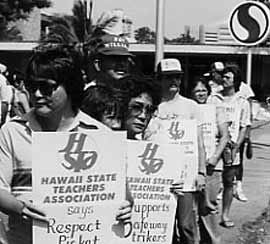
In the 1980s, members of the Hawaii State
Teachers Association supported striking Safeway
workers.
Photo Courtesy of the United States Bureau of Labor Statistics
Union Membership Across the United States
The rate of union membership in the United States has declined steadily since 1983 when it peaked at 20.1%. Today it is a little over 13%. Some blame foreign competition for the loss of union jobs in the industrial sector, especially the steel and automotive industries. Automation also eliminated the need for some workers on assembly lines. In addition, many companies, located in states where unions were powerful, moved their factories to states that had right-to-work laws and few unions. Hawaii, New York, Alaska, New Jersey, and Michigan had the highest rate of union membership--over 20%-- in 2002.
|

